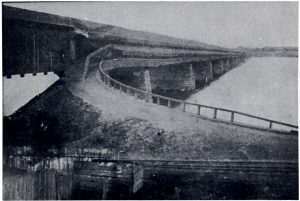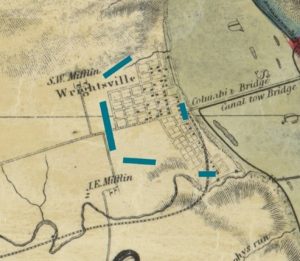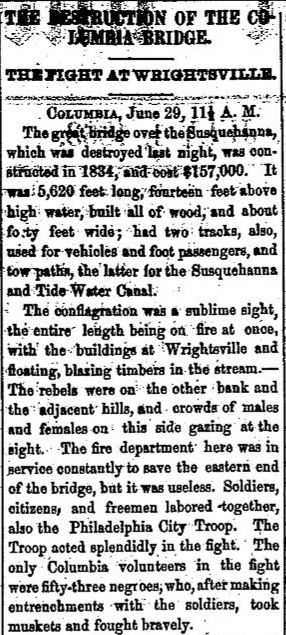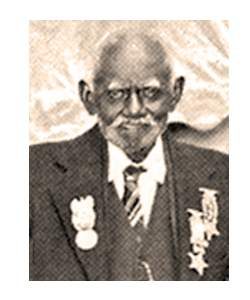RiverRoots: The Black Defenders of the Susquehanna
RiverRoots: The Black Defenders of the Susquehanna
River Roots is Susquehanna NHA’s blog series featuring history from York and Lancaster Counties that showcases the Susquehanna River’s historic, cultural, and natural resource contributions to our nation’s heritage.
Susquehanna NHA is pleased to introduce guest blog writer, local historian, and author Scott Mingus.
RiverRoots Heritage Blog
Join Mr. Mingus for a lecture at Columbia Crossing River Trail Center on December 13, 2023! This is a part of SNHA’s RiverRoots LIVE! Lecture Series.
Purchase Tickets Here!
The Black Defenders of the Susquehanna
In the late spring of 1863, the Army of Northern Virginia, the Confederacy’s main military force in the Eastern Theater of the Civil War, began moving north through Virginia and Maryland toward south-central Pennsylvania. Its commander, famed General Robert E. Lee, hoped to win a major victory on Northern soil, sever critical Union supply routes, and gather much-needed supplies. A full third of his army, Lt. Gen. Richard S. Ewell’s Second Corps, had arrived in Franklin County by June 23 and the remainder was well on the way.
Ewell split his powerful corps, leading two divisions northeasterly through lush Cumberland County toward Pennsylvania’s capital city, Harrisburg, while Maj. Gen. Jubal Early’s 6,600-man division headed east through Adams County, capturing fresh horses and supplies along the way. After a brief fight at Gettysburg on a rainy Friday, June 26, Early left the next morning for York, the largest town between Harrisburg and Baltimore. He would ransom York for $100,000 in cash and massive amounts of shoes, boots, food, flour, cattle, and other goods.
Terrified citizens fled as Ewell’s twin columns marched steadily toward the vital Susquehanna River bridges at Bridgeport (now Lemoyne) and Wrightsville, which provided access to strategically important Harrisburg. General Lee had instructed Ewell to “capture Harrisburg, if it comes within your means.” Town after town fell to the approaching Confederates and by, Sunday, June 28, Carlisle and York were firmly under enemy control, as was Chambersburg.
Defending the broad river became a priority to halt or delay the Confederates long enough for the pursuing Union Army of the Potomac to catch up and bring Lee to battle. Those plans included potentially burning sections of the Camelback Bridge at Bridgeport and Columbia Bridge at Wrightsville if necessary to prevent the Confederate soldiers and their artillery and wagons from crossing the Susquehanna.

A motley force of Union troops and civilian home guard companies assembled at Wrightsville. They included a full regiment of hastily organized and barely trained Pennsylvania emergency militia and several companies from other state-authorized units, including detachments of cavalrymen from Philadelphia and Gettysburg. The five home guard units defending the Wrightsville crossing included four companies of white men from Lancaster County and one of Black volunteers, mostly employees of the Maltby & Case Rolling Mill in Columbia. The latter group made an immediate impression on the soldiers. “They presented a motley appearance, attired as they were in every description of citizens’ dress,” an observer later wrote (Pottsville Miner’s Journal, 24 October 1863). None wore uniforms; most carried outdated weapons.
Earlier in the year, abolitionist Frederick Douglass had visited Lancaster County to raise men for the 54th and 55th Massachusetts Infantry, Black soldiers serving under white officers. Forty-one men from the river region signed up for the two regiments at various times and headed for Boston. Now, more than 50 other Black men in Captain William Case’s home guard company shouldered weapons to help defend the mile-and-a-quarter-long Columbia Bridge, the longest covered bridge in the world. They lacked uniforms and military equipment, so the 27th Pennsylvania Volunteer Militia’s quartermaster supplied them with modern rifle muskets and ammunition. Until the enemy arrived, however, these Black home guardsmen toiled side-by-side with the state soldiers to dig trenches and protective rifle pits (much like World War II’s foxholes). Lieutenant Francis Wallace, a newspaper reporter from Pottsville, served in the 27th Militia. “No men on that day worked more faithfully or zealously, than the colored company,” he later wrote. “Their conduct elicited the admiration of all who saw them” (Pottsville Miner’s Journal, 24 October 1863).
York lawyer James W. Latimer and his friend James Kell took a train to Harrisburg to see Governor Curtin, a fellow Republican, to get an update on the Confederate invasion. Peering out the window of his railcar as it approached Wrightsville, Latimer watched the back-breaking construction efforts in the fields to the north. “They are digging rifle-pits and throwing up entrenchments at Wrightsville to protect the Columbia bridge and say they are acting under orders from Gen. Couch. They have a force of men on the bridge night and day to destroy it if necessary.”

Throughout Sunday morning, June 28, a steady stream of refugees passed through the Union position on the turnpike between York and Wrightsville. They shared graphic descriptions of the Confederate advance through Adams and York counties. The excitement that morning was high, despite a persistent drizzle. The fleeing crowds included large numbers of Black men, women, and children, as well as hordes of livestock. Lieutenant Wallace observed, “The negroes are especially anxious to elude the rebels as they fear they would be made slaves if captured” (Pottsville Miner’s Journal, 4 July 1863). Despite the danger, Captain Case’s Black volunteers stayed put, even when the four companies of white home guardsmen returned to Columbia for breakfast but failed to return.
Alongside the 27th Militia, the 53 Black men, including 15-year-old John Aquilla Wilson of Fawn Grove in southeastern York County, continued entrenching. A few must have questioned their fate should they fall into Confederate hands. Free Black people who were captured by Confederate forces throughout the war often received shackles and a trip into slavery. Even uniformed Black soldiers were not treated as prisoners of war in several cases. The Wrightsville volunteers kept their muskets and ammunition stacked nearby.
At 5:30 p.m. on Sunday, distant Confederate artillery opened fire on the entrenchments. The defenders huddled behind the earthworks as shell fragments rained down, almost decapitating one of the Black guardsmen. A New York Herald reporter wrote, “Our men gave them a volley or two from their rifle-pits, knocking six or eight over and losing two themselves, one of whom belonged to a colored company organized in the town. His head was shattered by a fragment from one of the enemy shells” (New York Herald, 30 June 1863).
Two hours later, as long lines of enemy soldiers began flanking the horseshoe-shaped position, the Union commander ordered a retreat across the bridge into Columbia. Civilian volunteers had previously prepared a 200-foot section of the bridge with charges of explosive gunpowder. Once most of the men were safely across, orders came to light the fuse. An “old colored man,” Jacob Miller, had the honor. He sat calmly smoking his cigar while the artillery shells whizzed overhead. Now, he touched that stogie to the fuse and scampered to safety. However, the explosion failed to destroy the sturdy bridge deck and merely blew out some side walls and pieces of the roofing. The charge “simply splintered the arch. It scarcely shook the bridge” (John Q. Denney deposition, 1863).

The black volunteer company performed well that day, surprising considering their lack of combat experience. A Philadelphia correspondent noted, “Two companies of colored troops remained in the intrenchments [sic] until ordered to retreat. They were volunteers, and behaved very well, except in the retreat, which was accomplished rather hastily.” They reassembled on a hill along Third Street in Columbia. The militia commander detached one group upriver to guard a ford at Bainbridge. They marched out to their new post, “bearing themselves like veteran soldiers” according to a witness. (Philadelphia Inquirer, 29 June 1863)
Having failed to destroy the bridge with explosives, the soldiers hastily doused the partially shattered section with coal oil and set it on fire. The wind shifted and soon the conflagration grew into an unquenchable inferno that engulfed the entire bridge. Six hours later, it was entirely gone as thousands of fascinated soldiers and civilians watched the flames dance into the night sky.
By morning, the Confederates were gone, having withdrawn at dawn toward York. The defenders had successfully accomplished their goal of preventing the enemy soldiers from crossing the Susquehanna River.
The Sunday events at Wrightsville had another favorable outcome—newfound respect for black volunteers. They had shouldered arms alongside the white soldiers and performed courageously. Lancaster’s Examiner and Herald trumpeted, “The only Columbia volunteers in the fight were fifty-three negros, who after making entrenchments with the soldiers, took muskets and fought bravely” (1 July 1863). In his official report, militia commander Col. Jacob Frick praised the excellent conduct of these black civilians. “After working industriously in the rifle pits all day, when the fight commenced they took their guns and stood up to their work bravely. They fell back only when ordered to do so” (War of the Rebellion: A Compilation of the Official Records of the Union and Confederate Armies, 27, pt.2, 279). Lieutenant Francis Wallace wrote to his Pottsville paper, “All honor to the colored men of Columbia. They will die in defense of life and liberty, which is more than a majority of the whites here seem disposed to do—the cravens” (Pottsville Miner’s Journal, 4 July 1863).

In Harrisburg, Darius Couch oversaw the Department of the Susquehanna, a military district stretching from the Laurel Highlands east to Philadelphia. He later wrote, “The militia of Pennsylvania raised to resist the invasion was composed of all classes and professions, and was a fine body of men.” Thankful for the hundreds of Harrisburg residents who constructed earthworks, he added, “Some of the patriotic citizens of that city volunteered to work in the trenches; others were paid. The colored population were not far behind their white brethren in giving assistance.”
Unfortunately, the name of the Black volunteer killed by Confederate artillery has been lost to history. Columbia’s black cemeteries and churches did not maintain detailed records during this period. The only existing muster roll for the Columbia Black volunteers is from November, well after the skirmish. Some Black men who shouldered muskets in the earthworks, including young John Aquilla Wilson of York County, later enlisted in three-year United States Colored Troops and fought in other battles against the Confederates. They never forgot their first military experience, defending the Susquehanna.

Meet the Guest Writer Scott Mingus
Scott L. Mingus, Sr., is a retired scientist and executive in the global pulp & paper industry, holds patents in self-adhesive postage stamps and bar code labels. He was part of the research team that developed the first commercially successful self-adhesive U.S. postage stamps. He is a multiple award-winning author, having written or co-written over three dozen books on the American Civil War and Underground Railroad. He also wrote several articles for Gettysburg Magazine and other journals. Scott maintains a blog on the Civil War history of York County PA and received the Heritage Profile Award from the York County History Center for his many contributions to local Civil War history.
